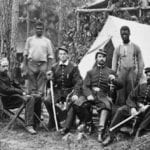 Mysteries
Mysteries  Mysteries
Mysteries  History
History 10 Surprising Stories About the Texas Rangers
 Humans
Humans 10 Philosophers Who Were Driven Mad by Their Own Theories
 Miscellaneous
Miscellaneous 10 Video-Game-Worthy Weapons and Armors from History
 Weird Stuff
Weird Stuff 10 Psychics Who Accurately Predicted Wartime Events
 The Arts
The Arts 10 Pieces of Art Inspired by a Broken Heart
 Health
Health 10 Science Fiction-Sounding New Medical Treatments
 History
History 10 Surprising Facts About the Father of Submarine Warfare
 Space
Space Ten Astonishing New Insights into Alien Worlds
 Weird Stuff
Weird Stuff 10 Bizarre Summer Solstice Rituals Still Practiced Today
 Mysteries
Mysteries Top 10 Haunting Facts About the Ghost Ship MV Alta
 History
History 10 Surprising Stories About the Texas Rangers
 Humans
Humans 10 Philosophers Who Were Driven Mad by Their Own Theories
Who's Behind Listverse?

Jamie Frater
Head Editor
Jamie founded Listverse due to an insatiable desire to share fascinating, obscure, and bizarre facts. He has been a guest speaker on numerous national radio and television stations and is a five time published author.
More About Us Miscellaneous
Miscellaneous 10 Video-Game-Worthy Weapons and Armors from History
 Weird Stuff
Weird Stuff 10 Psychics Who Accurately Predicted Wartime Events
 The Arts
The Arts 10 Pieces of Art Inspired by a Broken Heart
 Health
Health 10 Science Fiction-Sounding New Medical Treatments
 History
History 10 Surprising Facts About the Father of Submarine Warfare
 Space
Space Ten Astonishing New Insights into Alien Worlds
 Weird Stuff
Weird Stuff 10 Bizarre Summer Solstice Rituals Still Practiced Today
Ten Civil War Generals Who Were Famous for Other Things
What do a Cherokee chief, best-selling author, Texas Ranger, President of the United States, and Episcopal bishop all have in common? They were all generals in the American Civil War. Many people may have heard of Robert E. Lee or Ulysses S. Grant, but there are far more Civil War generals that have faded into the background.
The bloodiest conflict in United States history and the last major war on the North American continent pitted brother against brother, bringing together an unlikely list of characters whose fame exceeded their actions on the battlefield.
Related: 10 Incredibly Tragic Stories Surrounding Devastating Wars
10 Lewis Wallace
Lew Wallace’s military career had its ups and downs, as he served in both the Mexican-American War as well as the Civil War. As one of Ulysses S. Grant’s generals, he was relieved of his command after allegations that he had been late in bringing reinforcements to the Battle of Shiloh in early 1862, claims which he would deny continuously. Later in the war, Wallace would halt Confederate General Jubal Early’s advance toward Washington, D.C., at the Battle of Monocacy, thereby protecting the capital.
His fame apart from the war began in 1878, when he was appointed territorial governor of New Mexico, where he ended the Lincoln County War and personally met with Billy the Kid to offer him amnesty. His final governmental position would be as an ambassador to the Ottoman Empire, which he held from 1881 to 1885.
His lasting fame came, however, from his literary career, most notably his 1880 book Ben-Hur: A Tale of the Christ, which was well-received both at the time and after that, leading to the 1959 film starring Charlton Heston as well as the 2016 remake.[1]
9 Lawrence Sullivan Ross
Lawrence Sullivan Ross’s family moved to Texas in 1839 and helped found the town of Waco, where “Sul,” as he was later called, spent much of his childhood. In 1860 he joined the Texas Rangers and assisted in the recovery of Cynthia Ann Parker, the niece of Texas politician Isaac Parker, who had been kidnapped by the Comanche Natives at a young age. After Texas seceded from the Union, he became a Confederate general and served with distinction in the western theater of the Civil War.
After the war, he operated his farm and ranch and became sheriff of Waco from 1873 to 1875, during which time he arrested nearly 700 outlaws. He was then elected a state senator and then governor of Texas. As governor, he focused on land-use reform in beneficial ways to farmers and ranchers, enacted tax-reform measures, and expanded state-sponsored charitable efforts. In 1891, the struggling Texas Agricultural and Mechanical College (now Texas A&M University) asked Ross to step in as its president, where he improved campus facilities and fostered a strong school spirit and tradition which remains to this day.[2]
8 Jefferson Columbus Davis
Jefferson Columbus Davis was a Union general who shared a name with the Confederate President—Jefferson Finis Davis—and shot and killed a superior officer over a disagreement in 1862. Davis served with distinction in the Mexican-American War and was stationed at Fort Sumter when Confederate forces bombarded it to begin the war. He commanded forces in the western theater of the war before being assigned to Louisville, Kentucky, under General William “Bull” Nelson. The trouble began here, as Nelson and Davis immediately disliked each other, with Nelson relieving Davis and sending him away.
Unfortunately for “Bull,” Davis was reassigned to Louisville. When he arrived and reported to Nelson, the two insulted one another and exchanged blows, after which Davis retrieved a pistol from a friend and shot General Nelson, who died within a half-hour. Davis was arrested but was soon released because of the army’s need for officers. He went on to serve throughout the remainder of the war, suffering no legal repercussions regarding the shooting but gaining fame and notoriety ever after.[3]
7 Benjamin McCulloch
Born in Tennessee in 1811, Benjamin McCulloch was a friend of frontiersman and eventual U.S. Senator Davy Crockett, who compelled McCulloch to ride to Texas to participate in the Texas Revolution in 1836. He served in the Battle of San Jacinto, which won the war for Texas, and then served as an Indian fighter with the Texas Rangers. He repelled Mexican raids into South Texas and fought in the Mexican-American War under future U.S. President Zachary Taylor.
Between the Mexican War and the Civil War, McCulloch’s exploits included becoming a gold prospector in California, also known as “49ers,” and negotiating peace with Brigham Young in Utah (LINK 18). After Texas’s secession in 1861, McCulloch was made a brigadier general and raised a significant army in Texas, which was successful in the western theater until his death at the Battle of Pea Ridge in Arkansas.[4]
6 James A. Garfield
Eventually elected the 20th President of the United States, James A. Garfield was first a Union general with many other distinctions. From humble origins in Ohio, Garfield became an educated man and a noted abolitionist. He became a general in the Union Army during the Civil War, serving notably in Tennessee until 1863, when he became U.S. representative for Ohio.
A Radical Republican, Garfield supported Reconstruction measures and was influential in financial decisions, strongly supporting anti-inflation and the gold standard. In addition to his congressional career, Garfield had a significant interest in mathematics, and in 1876 he published a well-reviewed proof of the Pythagorean theorem.
He defeated fellow Union general Winfield Scott Hancock in the 1880 presidential election and pushed reform during his time in office, including civil rights for former slaves. In 1881, however, Charles Guiteau shot the president, who had previously refused him a political office. Despite an initial recovery, infection from doctors’ hands eventually killed Garfield. He was only in office for about 200 days— March 4, 1881 to September 19, 1881.[5]
5 John C. Breckinridge
From a prominent Kentucky family which included Thomas Jefferson’s attorney general, John C. Breckinridge was an affluent politician in the years preceding the Civil War. He studied law at Princeton and graduated from Transylvania University, later being elected to the Kentucky state legislature in 1849. A states’ rights Democrat, he was then quickly elected to the U.S. House as a representative for Kentucky, where he gained notice as a solid party-line voter.
In 1856, Breckinridge was selected as the running mate for James Buchanan’s successful presidential bid, becoming the youngest vice president ever at 36. When Abraham Lincoln, head of the newly-founded Republican Party, ran for president in 1860, the Democrats were split in nominating his contender, with Southern states nominating Breckinridge and Northerners preferring Stephen Douglas.
Regardless, Lincoln was elected president, and Breckinridge accepted a Senate seat, which he quickly resigned as his sympathies lay with the new Confederacy, where he was given a generalship. He dealt with his struggles throughout the war, not being a professional military man, and had a bitter rivalry with fellow general Braxton Bragg. He survived the war but died of cirrhosis in 1875.[6]
4 George B. McClellan
Like Breckinridge, George Brinton McClellan also lost a presidential campaign to Abraham Lincoln, though it was four years later in 1864. Before that, McClellan was a career military man, serving with distinction in the Mexican-American War and acting as an observer during the Crimean War. After the poor showing of the Union Army at the First Battle of Manassas in 1861, Winfield Scott resigned his position as General-in-Chief, which was given to McClellan by Abraham Lincoln.
McClellan proved to be very adept at training and organization and can be credited with massively improving the Union Army, but his battlefield legacy would haunt his career. With a reputation for being overly cautious, he was blamed for failing to make any headway against Confederate forces and was replaced by Henry W. Halleck after the Seven Days Battles in 1862.
As mentioned above, 1864’s presidential election saw McClellan running against Lincoln on a campaign to end the war by negotiating with the Confederacy. However, he lost by a considerably wide margin. After the war, he was elected governor of New Jersey and spent the rest of his post-official life defending his wartime legacy.[7]
3 Stand Watie
A general with the twofold distinction of being the last Confederate general to surrender as well as the only general on either side with Native American ancestry, Stand Watie was born with the name Degadoga (meaning “He Stands”) on Cherokee land in Georgia. He was active in tribal politics as one of four chiefs who signed the Treaty of New Echota, which traded traditional Cherokee land in Georgia for new land which would become the Cherokee Nation in modern-day Oklahoma. The result was the “Trail of Tears” and a lifelong rivalry with disagreeing factions led notably by Chief John Ross, who executed the other signers of the treaty, with Watie escaping.
When the Civil War broke out, Watie joined the Confederate Army, eventually reaching the rank of brigadier general, fighting mostly in the Arkansas, Louisiana, and Indian Territory. Watie was the last Confederate general to surrender to the Union in June of 1865 and was later a delegate to the re-negotiation of treaties with the United States in September 1865. The character of Lone Watie in Clint Eastwood’s 1976 film The Outlaw Josey Wales is loosely based on Stand Watie.[8]
2 George Crook
After his service in the Civil War, George Crook was a storied general of the Old West. He graduated from West Point in 1852 and saw action throughout the Civil War, notably under Philip Sheridan in the Valley Campaign of 1864. His real fame, however, began after the war when he was detached to the west to address problems with several Native American tribes. He led expeditions against the Sioux in the mid-1870s, which included his defeat at the Battle of the Rosebud in 1876, whose outcome may have decided George Custer’s fate at Little Bighorn.
Crook returned to Arizona in 1881 to fight the Apache tribe largely led by famed warrior Geronimo. Nicknamed the “Tan Wolf” by Apache, he was considered a strong enemy with respect for his adversary. While in pursuit, Crook went off alone hunting for food, where he came face-to-face with Geronimo and his warriors, who did not attack but came to discuss peace terms, which Crook negotiated fairly.
Unfortunately for Crook, Geronimo violated the terms of surrender, which necessitated Crook bringing him back once again. Shortly after, Crook lost his post. He spent his final years trying to ensure the U.S. government would keep its word concerning Indian treaties, which was noticed by his former enemy Chief Red Cloud, who said, “He never lied to us. His words gave my people hope”.[9]
1 Leonidas Polk
Leonidas Polk’s career began and ended martially, graduating from West Point in 1827 and dying from a cannonball shot during the Atlanta Campaign as a Confederate general in 1864. But in between, his time was spent not in the barracks but at the pulpit as an Episcopal priest and later bishop.
In 1838 he was appointed Missionary Bishop of the Southwest and later Bishop of Louisiana in 1841. His life’s work culminated in 1860 when he broke ground for the new University of the South in Sewanee, Tennessee, which stands to this day). When the South seceded in 1861, Confederate President Jefferson Davis, an old friend, convinced Polk to accept a generalship in the Confederate Army.
As a general, he was well-liked by his men, but not by his superior, General Braxton Bragg, who felt his quality as a military leader was lacking. Polk was positioned between Sherman and Atlanta in 1864 when a volley of cannon fire ended his life just four years before the opening of his university.[10]








